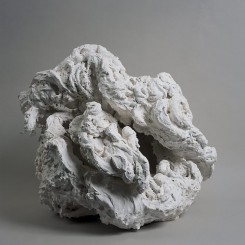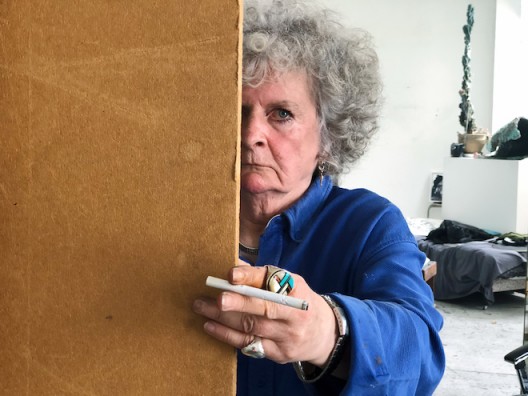An interview with Maggi Hambling
“For Beauty is Nothing But the Beginning of Terror: Maggi Hambling Paintings and Drawings, 1960–”
Central Academy of Fine Art Art Museum, Beijing, March 8–May 1, 2019
by Christopher Moore
Maggi Hambling (b. 1945) is one of Europe’s leading figurative artists, renowned for portrait painting and drawing, but also for her paintings of the sea near where she lives in Suffolk, England, and her sculptural works, from the monumental to the intimate. This spring, Hambling will exhibit for the first time in China, at the Central Academy of Fine Arts Museum in Beijing. The CAFAM exhibition revolves around two main groups of work: a retrospective of Hambling’s drawings and two series entitled “Walls of Water”, a series of eight large-scale paintings that was shown at the National Gallery in London and a subsequent series of ten monotypes shown at the Hermitage Museum in Saint Petersburg. Ran Dian met the artist at her London home to discuss the show.
Maggi Hambling is smoking. Fag ends litter the painted floorboards of her bright South London studio. Paintings are stacked around the walls; maquettes crowd tables and window sills. As I enter, Maggi sits at her drawing board, fixing me with a hawk-like gaze. A Juergen Teller photo perfectly captures this look. But Maggi’s twinkling eyes and laughter give the game away, revealing a warm and raucous personality—though there is occasional self-doubt disguised with self-deprecation too.
We start by discussing her drawings and I ask her how they relate to her paintings. Maggi lights up.
Maggi Hambling: “The Walls of Water paintings which we’re going to show [at CAFAM], and the monoprints, would have been impossible unless I had got up early every morning and gone to the North Sea near where I live in Suffolk and made drawings… [Drawing] came into my life when I was 7 or 8 and it is the basis of everything I do.”
But Maggi wants to emphasize how she works generally: “My great thing is: as Brancusi said, ‘It isn’t difficult to make a work of art but difficult to be in the right state to do it.’* I try to become a ‘CHANNEL’ so that the truth of the subject can come through me into the canvas, on to the drawing, whatever it is I’m working on. So, there’s a subject that’s in charge of me rather than the other way around.” I note that in China, the distinction between painting and drawing is seen as somewhat artificial. “They’re absolutely right! Look at ‘Laughing 2’ (2018), is it a drawing or a painting?”
It is true. Certain people in England, particularly in art history, tend to get very hung-up on superficial definitions (Brexit is a form-over-substance example). Maggi agrees: “They always want to make you an ‘–ist’! I’ve always refused to be an ‘-ist’. If anyone says I’m an expression-ist, a portrait-ist, a landscape-ist – [I say] no, I’m not! Because the moment one’s an -ist, you’re safely put in a box somewhere and they’ve got you!” and walleyed Maggi gestures cutting her throat.
The problem is not just a matter of categorizing or the category itself, but that categorization stops people looking and Hambling wants you to look, to really pay attention: who is this person she has drawn? How is the sea moving? Why is this huge stainless-steel scallop shell rising up on the Suffolk beach? This is not simply a matter of contemplation: she wants you to feel what is going on: the movement in a face, a body, a person; the surging winter waves; even the echo of Benjamin Britten’s opera, Peter Grimes.
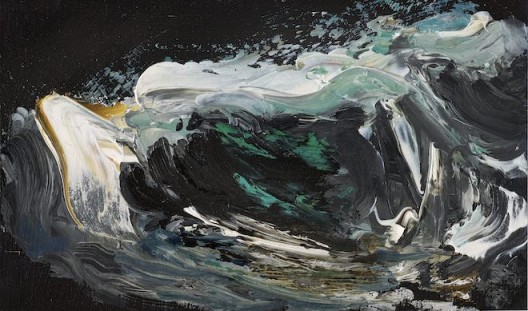
Maggi Hambling, Night wave breaking 1, oil on panel, 11 x 18 cm, 2005 崩碎的夜浪 1, 2005, 木板油画, 11 x 18 厘米 , 私人收藏 (image courtesy the artist and Marlborough Gallery)
The Color of the North Sea
I ask Maggi about color. I am thinking of her portraits, but she seizes upon the example of her sea paintings. “People talk about the North Sea as being grey but to me it isn’t, it’s full of color! All those bronze, silver, pewter colors but also wonderful moments of turquoise and raw sienna. The color comes from what I see in front of me.” Hambling uses color, in drawings and paintings, in portraits, seascapes and on bronzes, not for merely decorative purposes but structurally. Shifts between lighter and darker hues, individual lines or broad patches of color speak to the particular personality of the subject. Fleeting moments of raw sienna or turquoise whether in her sea paintings or portraits, emphasize both movement and time, and perhaps precisely because both the moods of people and the of the sea are equally changeable and fleeting. Color is not just texture and emotion. Color is time.
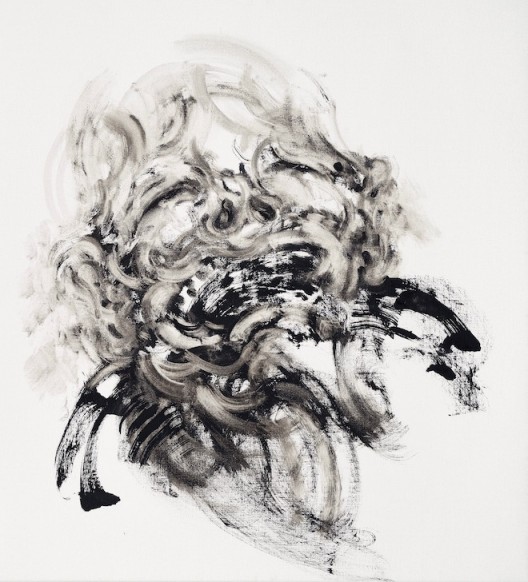
Maggi Hambling, Laughing 2, oil on canvas, 66 x 61 cm, 2018 笑 2, 2018 布面油画, 66 x 61 厘米 私人收藏 (image courtesy the artist and Marlborough Gallery)
Henrietta
“I re-met Henrietta on 4 February 1998, two days after my father’s funeral, at the end of a dinner following the Francis Bacon opening at the Hayward Gallery in London.
Those eyes had first blazed through mine across a large Boxing-Day lunch in Wiltshire five years earlier. The next significant encounter concerned money: Henrietta wrote asking for £400 to settle some annoying bills and in exchange she would work. It all began at the end of May and she posed most Mondays for the next seven months.” – as recounted in the book Maggi & Henrietta.
Henrietta Moraes was a long-term member of Soho’s demimonde. She was painted by Francis Bacon 15 times. By all accounts, she had a fierce, incandescent personality. At the end of her life, Maggi and Henrietta became close and Maggi painted and drew Henrietta many times, including after death. The portraits form a passionate tribute to a life and a life lived.
Maggi: “If we go back to that [painting] of Henrietta, that was done at the very end of the day. I had tried – tried– several portraits on that canvas and they had all failed. I had started at 9 o’clock in the morning and it got to 4 in the afternoon and I was absolutely exhausted. So, I got a turpsy rag and removed all that paint that remained and this sort of grey wash remained. And I thought, I’ll have one more go. So that painting, and it’s one of my best paintings, happened in about 20 minutes but I couldn’t have made that unless I had made the bundles of shit beforehand – one after another! Then that [portrait] just happened.”
Maggi makes the point a number of times that her paintings are not matters of forethought or procedural consideration but emanations of the very process of painting. She is possessed by the act of painting, drawing, creating. “To get back to the Brancusi quote, about being in the right state to do it [to make art], I am only aware of the bad painting that has to be got rid of. But when the painting paints itself, those are the moments one works for and I’m not at all aware of what I’m doing.”
I want her to spell this out, so I ask whether to get to that symbiotic point, one of her paintings has got to go through all of the other states of failure first. She answers emphatically: “Oh yes! I can work for months on a painting and then destroy it, and then that painting can suddenly happen [be finished] in a morning but only because of all the months of doubt and failure that have preceded it. And the moment when it happens! – like that painting of a waterfall there happened very, very quickly!” Maggi nods towards a tall, narrow canvas leaning on the wall behind her that could easily be mistaken for a classical Chinese shanshui painting.
Style and experimentation
“I never think about style…I try to constantly — it’s an overworked word – to experiment! The paintings of the sea led on to the ‘Walls of Water’, which again, in turn, resulted from witnessing the great storm that occurred just up the coast from where I am in Suffolk. And then came the ‘Ice Cap Melting’ paintings. One thing leads into another and I’m constantly on the move. I’m still amazed – at the grand old age of 73! – I’m still surprised by what oil paint can do!
“I think the word ‘style’ is something that other people may use but I don’t use it myself. When I’m painting the sea, I’m trying to make that energy of the sea happen on the canvas. And of course, movement; I hope people see that, also in my portraits.” Maggi shrieks with laughter, “– unless they’re of dead people! – I hope you [can] see that they’re still breathing!” Maggi is renowned for continuing to draw and paint portraits of close family members and friends, years after they have died. Maggi recomposes herself and looks at me intently again. “So, the energy of movement is of crucial importance, [whether] the energy of water or whether the person I am drawing gets up and makes a joke.”
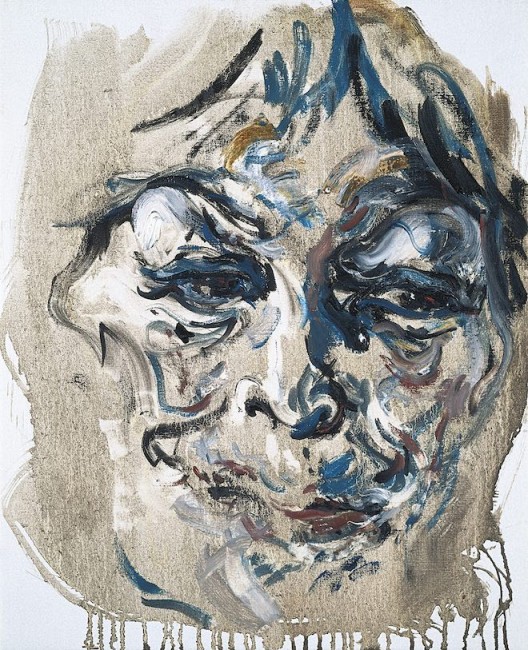
Maggi Hambling, Henrietta June, oil on canvas, 53 x 43 cm, 1998 亨丽埃塔,1998 年 6 月,1998 布面油画, 53.3 x 43.2 厘米, 私人收藏 (image courtesy the artist and Marlborough Gallery)
Movement
“Movement is very important in my work. When I’m painting the sea or the ‘Walls of Water’, it’s that energy of the waves that I try to recreate with oil paint on canvas, so that the eye, the viewer’s eyes, are kept on the move the whole time. My eyes — say I was painting you — would be on the move the whole time, to see the relationship between the top of an ear and the corner of your mouth or the top of your forehead and your Adam’s apple. This is the thing that I think oil paint can do that photography can’t do, because however much you might be moved by the subject, say by Diane Arbus or Juergen Teller, it’s history because it’s behind glass and it’s happened. But with great painters — Rembrandt, Cy Twombly, Jackson Pollock — it is as if it’s happening in front of you. That’s why I think painting will never die because if it’s got any life to it, it is as if it’s happening in front of you, if you think of late-Titian, or late-Rembrandt, or Rothko or van Gogh.”
Now we are looking at portraits, paintings and drawings. “So many portraits seem to me to be completely dead. They are of dead people even when someone is trying to paint them when they’re alive.” This is something I have been wanting to discuss with Maggi, because not only does she frequently continue portraying family and lovers, years after they have died, but actually also quite frequently people asleep or dreaming. So I say, “To be honest, to me even your memento mori, your skulls, seem to have a lot of movement. It’s your way of drawing. Sometimes it’s more abstract, sometimes it’s more detailed, but the line is present in everything. So, the relationship between the drawings and the paintings — and the paintings [about water] can be very abstract … but even in these paintings line is very important.…”
Well, I used the wrong words. One in particular.
MH: “Now look here Chris Moore! You’re using the word ‘abstract’ — I always fight that off in every way possible! There’s nothing abstract in my work! Lett [Haines, one of Maggi’s teachers] used to say the only true abstraction is the circle, the square and the triangle. I dispute the word ‘abstract’! I don’t hold with it in regard to my work. It’s all figurative. You have to use ‘abstract’ qualitatively, if you like, for tension and composition, but all my work comes from something around me and is dictated by what happens to me in life. If someone has died, I go on painting them, if it’s someone I love.” She stares at me and slips the knife in. “Generalization is the worst enemy of art…When I am drawing a person, it has to be as if I have never seen an eyebrow before, or never seen an elbow or foot, otherwise it wouldn’t have any life to it.”
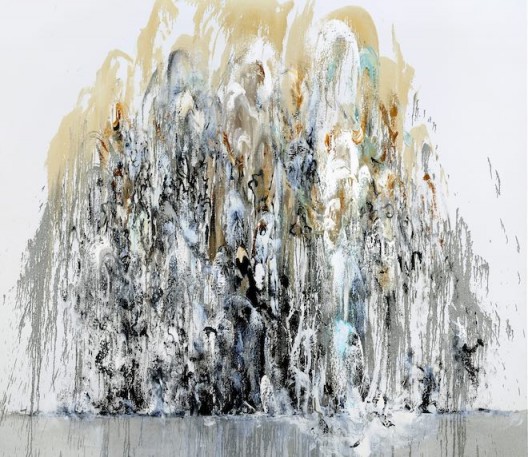
Maggi Hambling, Wall of water 1, oil on canvas, 198 x 226 cm, 2010 (image courtesy the artist and Marlborough Gallery)
Walls of water
Conversation has been segueing from theme to theme and back and forth and briefly we return to Henrietta but not in the particular but as artist’s model, a ‘sitter’.
Maggi: “The subject has to be in charge. Something my first art teacher said to me was that the artist doesn’t choose the subject, the subject chooses the artist. So, the subject, be it Henrietta or a ‘Wall of Water’ has to be in charge of me, I am the channel and it comes through me onto the canvas or paper. So, this emptying of myself, of all my bullshit, baggage and all that stuff, that’s the difficult bit: to get rid of all that, so that the painting can happen. The subject must dictate every mark I make.”
Expecting Maggi to continue discussing portraiture, I ask her ‘How does the subject choose you?’ but she wrong-foots me. By now, this is unsurprising. For Maggi, each painting, each drawing, each monotype-print and each bronze or ceramic sculpture is most particular. Yet while each is composed of unique histories and locations which define their making, the process of making them, the artist using herself as a sort of existential conduit for their making, inevitably creates relationships between them, in the swirling lines of a lover’s face or the rage of the coastal tempest. This is not a matter of anthropomorphism but how she experiences life, whether with people or nature. “I paint what happens in life. With the ‘Walls of Water’ I was at Southwold during this incredible storm, this force of nature — very frightening, very beautiful — happening in front of me. And those paintings couldn’t have happened unless I had made many sea paintings before them. And I don’t think the energy of those sea paintings would have happened unless I had made this plaster sculpture of Henrietta, of her mouth, eating a meringue.”
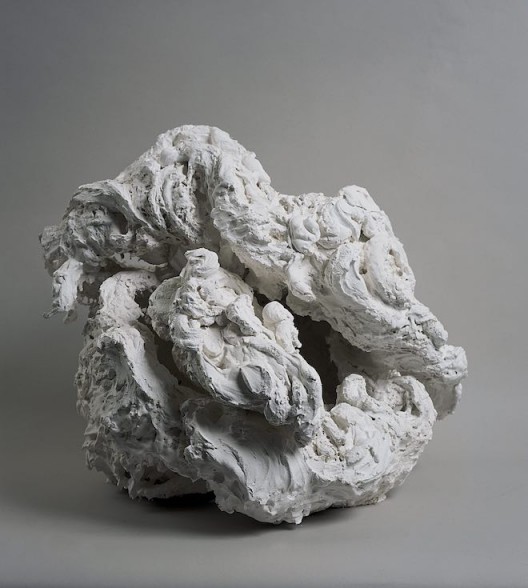
Maggi Hambling, Henrietta eating a meringue, plaster, 51 x 60 x 60 cm, 2001 (image courtesy the artist and Marlborough Gallery)
“It was a year later that I realized that the kind of movement going on, between the mouth and the lips and the meringue, the mouth becoming a meringue and the meringue becoming a mouth, was the energy I wanted to get into the sea paintings. I feel the sea is like a mouth because it’s devouring, erosion is happening, the coastline changes the whole time.” Maggi has a critical eye, but it is not egotistical. As a man, I hesitate to describe any female artist’s work as romantic but the romance in Maggi’s work is grand and Proustian, the great forces of nature, sex and storms, colored by laughter, loss and time.
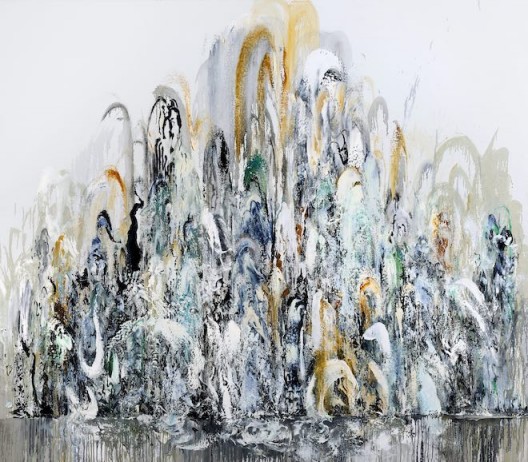
Maggi Hambling, Wall of water 2, oil on canvas, 137 x 170 cm, 2011 (image courtesy the artist and Marlborough Gallery)
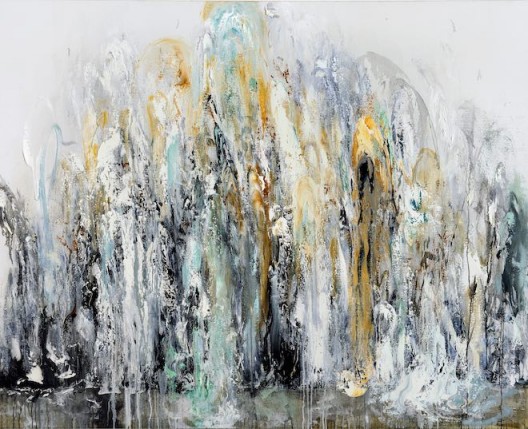
Maggi Hambling, Wall of water 3, oil on canvas, 198 x 226 cm, 2011 (image courtesy the artist and Marlborough Gallery)
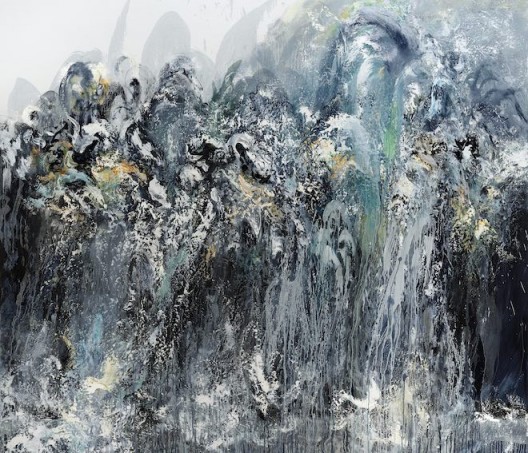
Maggi Hambling, Wall of water 5, oil on canvas, 198 x 226 cm, 2011 (image courtesy the artist and Marlborough Gallery)
The eye, the hand and the heart
We have been talking for almost two hours and we are finishing up. I ask if I can photograph her shoes. I get another odd look, but I insist the leopard-print shoe with starfish-pattern socks on the floor littered with cigarette butts says something good, too. Maggi laughs and obliges with aplomb. Before I leave though, Maggi wants to emphasize her view one more time, insists upon it. The words are measured and modest, and they sum up how and why she paints, draws and sculpts: “A couple of times you’ve used the word ‘thinking’, and I try not to think at all. [When making art] there’s the eye, the hand and the heart, and the heart is the most important. My work is about love really, however corny that sounds.”
* “It is not the work itself, it is to keep oneself in condition to do it, that is difficult.” Quoted by Dorothy Dudley, Brâncuşi, Dial 82, February 1927
Short Bibliography
Maggi & Henrietta. Drawings of Henrietta Moraes by Maggi Hambling. Preface by John Berger (Bloomsbury: London, 2001)
Maggi Hambling with James Cahill. War Requiem & Aftermath. Unicorn Press Ltd: London, 2015
Jennifer Ramkalawon, Maggi Hambling Touch: Works on paper, Ex. Cat., Lund Humphries in collaboration with The British Museum: London, 2016.
Maggi Hambling. The Works, Unicorn Press: London, 2006
Short Biography
1945 Born Sudbury, Suffolk
1981 National Gallery, London
1983 National Portrait Gallery, London
1987 Serpentine Gallery, London
1991 Yale Center for British Art, New Haven, Connecticut
1995 Jerwood Painting Prize, Royal Academy of Scotland, Edinburgh and Royal Academy, London,
2007 Fitzwilliam Museum, Cambridge
2013 The Hermitage, Saint Petersburg
2015 Somerset House, London
2018 National Gallery, London
2019 Central Academy of Fine Art, Beijing



